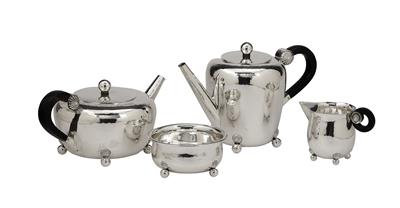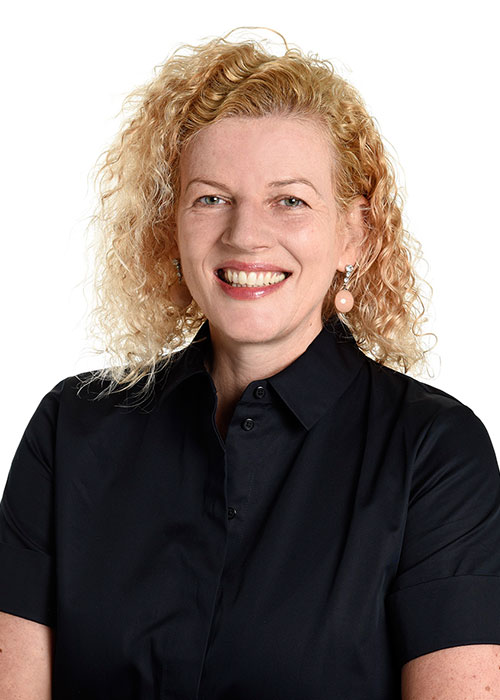Paula Straus (Stuttgart 1894–1943 Auschwitz), a four-part coffee and tea service, model: 13420, P. Bruckmann & Söhne, Heilbronn, manufactured as of 1930
Paula Straus (Stuttgart 1894–1943 Auschwitz), a four-part coffee and tea service, model: 13420, P. Bruckmann & Söhne, Heilbronn, manufactured as of 1930

consisting of: coffee pot with cover (height 17.5 cm), teapot with cover (height 12.7 cm), creamer (height 9.7 cm) and sugar bowl (height 6 cm); silver, mould-pressed, hammered; ebony, dark patinated; ear-shaped and circular handles attached to the shoulder with cylindrical elements in the guise of round cast rosettes; each with four spherical feet, the upper section with round cast rosettes; traces of use; undersides marked with no. 13420, crescent, crown, 835 and eagle, the coffee pot additionally with ‘Buchwald’, the teapot with the number 65, the creamer with 72; weight: 1,666 g. (MP)
Literature:
Frauensilber, Paula Straus, Emmy Roth & Co, p. 57, no. 10; PBS calculation book, no. 13420, 4 June 1930; DGK 22, 1931, p. 436; Großsilberwaren catalogue no. 66, P. Bruckmann & Söhne, Heilbronn a. N., Preisliste über silberne Tafelgeräte, Heilbronn, September 1931, p. 1; 10 Jahre Werkbundarbeit in Württemberg, 1930, p. 60, ill. 2; Die Form 7 (1932), p. 322 with ill. et passim.
Paula Strauss (1894-1943) was one of the first women to be trained as a goldsmith and silversmith and to become successful in their profession. She commenced her training as a goldsmith and silversmith in Schwäbisch Gmünd and at the Kunstgewerbeschule on the Weissenhof in Stuttgart. After obtaining her diploma in 1921 under Paul Haustein, she continued to work as a master craftswoman at the Kunstgewerbeschule, achieving great recognition with her pieces of jewellery, which were also shown at exhibitions of the Deutscher Werkbund. In 1925, the silverware manufacturer Peter Bruckmann employed her in his company in Heilbronn, where she spent the next eight years creating over 100 designs for hollow-ware and cult objects in a formal style close to the Bauhaus tenets. Thus wrote Eduard Reinacher about Paula Straus’ style in Dekorative Kunst (XXXVII, p. 243) in 1929: “The factory thus gained a new force at the forefront, an artist who in her previous work cultivated the aristocratic individualism of exclusive craftsmanship, but was free from narrow-mindedness and beyond all snobbery, always open to the tradition of craftsmanship, the currents of the times and the stimuli of trends that were asserting themselves everywhere.” In 1933, Straus’s life took a dramatic turn. After Bruckmann dismissed, she was employed by the WMF in Geislingen for a few months before she had to give up this position probably due to anti-semitic decrees. When the National Socialists came to power, she, like most of her Jewish fellow citizens, found it increasingly difficult to pursue her profession. She first tried to make a living as a free goldsmith. After a failed attempt to escape to Holland, Paula Straus was banned from working on 1 January 1939. She was arrested in 1942 and murdered in the Auschwitz concentration camp the following year, at the age of 49.
Specialist: Dr. Magda Pfabigan, M.A.
 Dr. Magda Pfabigan, M.A.
Dr. Magda Pfabigan, M.A.
+43-1-515 60-383
magda.pfabigan@dorotheum.at
09.07.2020 - 16:00
- Estimate:
-
EUR 5,000.- to EUR 8,000.-
Paula Straus (Stuttgart 1894–1943 Auschwitz), a four-part coffee and tea service, model: 13420, P. Bruckmann & Söhne, Heilbronn, manufactured as of 1930
consisting of: coffee pot with cover (height 17.5 cm), teapot with cover (height 12.7 cm), creamer (height 9.7 cm) and sugar bowl (height 6 cm); silver, mould-pressed, hammered; ebony, dark patinated; ear-shaped and circular handles attached to the shoulder with cylindrical elements in the guise of round cast rosettes; each with four spherical feet, the upper section with round cast rosettes; traces of use; undersides marked with no. 13420, crescent, crown, 835 and eagle, the coffee pot additionally with ‘Buchwald’, the teapot with the number 65, the creamer with 72; weight: 1,666 g. (MP)
Literature:
Frauensilber, Paula Straus, Emmy Roth & Co, p. 57, no. 10; PBS calculation book, no. 13420, 4 June 1930; DGK 22, 1931, p. 436; Großsilberwaren catalogue no. 66, P. Bruckmann & Söhne, Heilbronn a. N., Preisliste über silberne Tafelgeräte, Heilbronn, September 1931, p. 1; 10 Jahre Werkbundarbeit in Württemberg, 1930, p. 60, ill. 2; Die Form 7 (1932), p. 322 with ill. et passim.
Paula Strauss (1894-1943) was one of the first women to be trained as a goldsmith and silversmith and to become successful in their profession. She commenced her training as a goldsmith and silversmith in Schwäbisch Gmünd and at the Kunstgewerbeschule on the Weissenhof in Stuttgart. After obtaining her diploma in 1921 under Paul Haustein, she continued to work as a master craftswoman at the Kunstgewerbeschule, achieving great recognition with her pieces of jewellery, which were also shown at exhibitions of the Deutscher Werkbund. In 1925, the silverware manufacturer Peter Bruckmann employed her in his company in Heilbronn, where she spent the next eight years creating over 100 designs for hollow-ware and cult objects in a formal style close to the Bauhaus tenets. Thus wrote Eduard Reinacher about Paula Straus’ style in Dekorative Kunst (XXXVII, p. 243) in 1929: “The factory thus gained a new force at the forefront, an artist who in her previous work cultivated the aristocratic individualism of exclusive craftsmanship, but was free from narrow-mindedness and beyond all snobbery, always open to the tradition of craftsmanship, the currents of the times and the stimuli of trends that were asserting themselves everywhere.” In 1933, Straus’s life took a dramatic turn. After Bruckmann dismissed, she was employed by the WMF in Geislingen for a few months before she had to give up this position probably due to anti-semitic decrees. When the National Socialists came to power, she, like most of her Jewish fellow citizens, found it increasingly difficult to pursue her profession. She first tried to make a living as a free goldsmith. After a failed attempt to escape to Holland, Paula Straus was banned from working on 1 January 1939. She was arrested in 1942 and murdered in the Auschwitz concentration camp the following year, at the age of 49.
Specialist: Dr. Magda Pfabigan, M.A.
 Dr. Magda Pfabigan, M.A.
Dr. Magda Pfabigan, M.A.
+43-1-515 60-383
magda.pfabigan@dorotheum.at
|
Buyers hotline
Mon.-Fri.: 10.00am - 5.00pm
kundendienst@dorotheum.at +43 1 515 60 200 |
| Auction: | Jugendstil and 20th Century Arts and Crafts |
| Auction type: | Saleroom auction |
| Date: | 09.07.2020 - 16:00 |
| Location: | Vienna | Palais Dorotheum |
| Exhibition: | 03.07. - 09.07.2020 |
